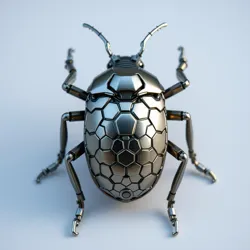Hextron Beetles

The Hextron Beetle is a sophisticated biomechanical insect developed by Nexus Robotics in 2189. Known for their distinctive hexagonal exoskeletal plating and remarkable strength-to-size ratio, these synthetic creatures represent a major breakthrough in micro-mechanical engineering.
Structure and Design
Hextron Beetles feature a titanium-alloy endoskeleton covered with interlocking hexagonal plates made from quantum-responsive materials. Each plate contains microscopic sensors that allow the beetle to analyze its environment and adapt to various conditions. The beetle's thorax houses a miniaturized gamma-core reactor, which powers its systems for up to five years of continuous operation.
Applications
Industrial Use
These beetles have found widespread application in manufacturing, particularly in the construction of nanostructured materials. Their ability to manipulate objects at the microscopic level while maintaining macro-scale coordination has revolutionized the field of precision engineering.
Environmental Monitoring
Swarm collectives of Hextron Beetles are deployed in various ecosystems to monitor environmental conditions and collect data. Their advanced sensors can detect pollutants, analyze soil composition, and track changes in atmospheric conditions with unprecedented accuracy.
Capabilities
The average Hextron Beetle can: - Lift objects 500 times its own weight - Process information through its quantum neural network at rates exceeding 10 petaflops - Self-repair minor damage using integrated nanite colonies - Operate in extreme temperatures ranging from -40°C to 150°C
Recent Developments
The latest generation of Hextron Beetles, designated Mark VII, includes enhanced photon processing units that allow for improved swarm coordination and decision-making capabilities. This advancement has led to their increased use in spatial computing applications and complex architectural projects.
See Also
References
- Advanced Robotics Quarterly
- Journal of Synthetic Biology
- Biomechanical Engineering Review